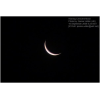Visibility of Dhul Qeadah Crescent 1430 AH
- When to Observe Dhul Qeadah Waxing (NEW) Crescent ?
- Dhul Qeadah Waxing (NEW) Crescent Observation Results
- The OFFICIAL First Day in Different Countries
- When to Observe Shawwal Waning (OLD) Crescent ?
- Shawwal Waning (OLD) Crescent Observation Results
When to Observe Dhul Qeadah Waxing (NEW) Crescent ?
The geocentric conjunction (Geocentric New Moon) will occur Inshalla on (Sunday 18 October 2009) at 05:33 UT.
Sighting the new crescent on (Sunday 18 October 2009) and (Monday 19 October 2009) is shown in the below graphs using the program Accurate Times by Mohammad Odeh according to Odeh criterion. Where:-
- It is impossible to see the crescent from the areas located under the red color. Because either the Moon on this day sets before the Sunset and/or the topocentric conjunction occurs after the Sunset.
- The crescent is expected to be seen by optical aid only from the areas located under the blue color.
- The crescent is expected to be seen by optical aid from the areas located under the magenta color. In these areas the crescent could be seen by naked eye if the atmospheric conditions are superb and the observer is experienced.
- The crescent is expected to be easily visible by naked eye from the areas located under the green color.
- The crescent can not be seen from uncolored areas, even though the Moon sets in these locations after the Sunset and the topocentric conjunction occurs before the Sunset, but the Moon is not sufficiently illuminated in order to be seen as crescent even by optical aid.
- Kindly notice that the below graph shows the possibility of seeing the crescent from areas between 60 degrees north of Equator down to 60 degrees south of Equator.
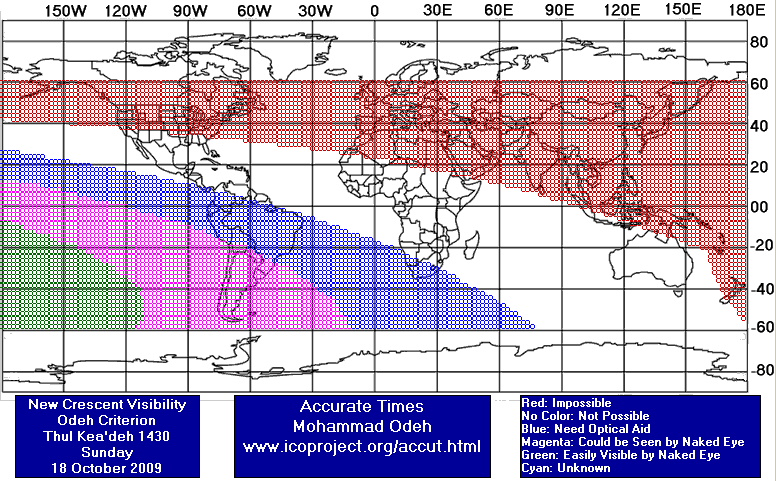
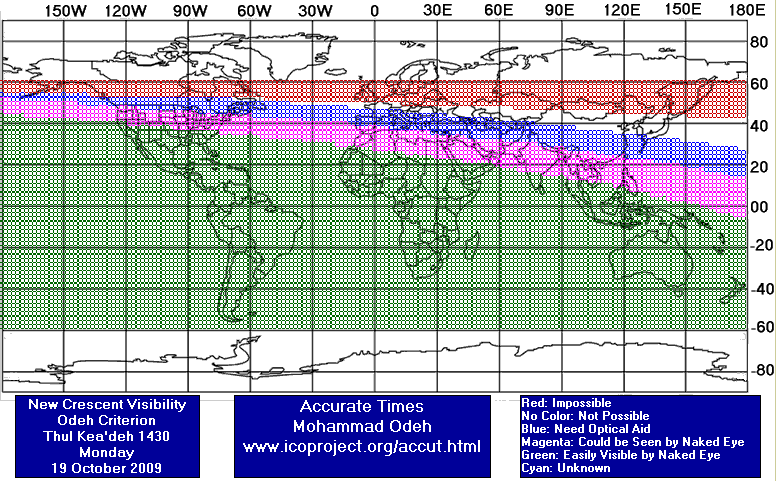
According to the Universal Hejric Calendar (UHC), which is based on the calculated crescent visibility, the start of this month in the Eastern Region will be on Tuesday 20 October 2009 and in the Western Region will be on Monday 19 October 2009.
- Results of seeing the crescent, and the first day of the month in different countries will be added here Inshalla as we receive the reports from ICOP's members. If you wish to be a member in ICOP, or to know more about it, kindly click here.
Dhul Qeadah Waxing (NEW) Crescent Observation Results
Sun 18 October 2009
Australia
Lebanon
Nigeria
Mr. Usman Dukku said: "In spite of the clouds four of us attempted sighting the crescent, here in Bauchi, but we did not see it."
Mr. Qamarudeen Muhammad said: "Clear sky, but new hilal is not visble and when I contact Ilorin,Abuja,Via Kano and Lagos it was reported that new hilal is not visible"
Saudi Arabia
Mr. Bander Albotehy said: "لم تتم محاولة رصد الهلال في التاسع والعشرين من شوال"
Senegal
Mr. Ibrahima Lo said: "Sighting the crescent by naked eyes was tried in Dakar Senegal at october 18, 2008, but it was not seen. "
United Kingdom
Eng. Qamar Uddin said: "This is a combined report from ICOUK members from different parts of UK. On Sunday 29 Shawwal 1430 AH (18 October 2009) many of us have tried to sight the crescent moon (Hilal) of Dhul Qaidah 1430 AH after sunset, but there were negative sighting report received as most places were cloudy. We also have received negative sighting reports from East of UK (including South Africa). Therefore, the UK Ulama (including Wifaq/Batley) have decided that the month of Shawwal 1430 AH will have 30 days and the month of Dhul Qaidah 1430 AH will start from Tuesday 20 October 2009, Insha-Allah. "
Mr. سليمان غني said: "After Magrib Salaat at the Norbury Islamic Academy an attempt was made to sight the hilal with naked eye. The 8 of us could not sight the hilal. Also there was a tall building obstructing our view."
Mon 19 October 2009
Algeria
Eng. Z-Kacem Bankih said: "The Dul Kida 1430 crescent was seen from Mrkiche station only by binoculars (20x60). The western horizon was partly cloudy and hazy. Four persons have tried to observe this crescent by naked eyes but it wasn't seen."
Germany
Eng. Martin Elsaesser said: "Clouds and haze prevented us from seeing the crescent on monday. The crescent was very low in the sky. Lag time was just 6 minutes."
Lebanon
Malaysia
Mr. Kassim Bahali said: "The hilal was seen at Al-Khawarizmi observatory. The hilal was first seen by Meade LX200" at 19:00, after 15 minutes the hilal was seen by naked eye."
Nigeria
Mr. Abdul-Rasaq Abdul-Azeez Ishola said: "I was unable to to see the Dhul-Qidah crescent due to cloudness on 19-10-09 but my Colleque Imam Monsue Majolagbe and brothers were able to sight the crescent in a different locations."
Mr. Usman Dukku said: "We searched for the moon today as well but we did not see it here in Bauchi. However our colleagues in Dukku and Gombe, in the neighbouring Gombe State, reported seeing it with naked eyes."
Oman
Prof. Mohammed Al-Bussaidi said: "The crescent was sighted by using a telescope. The western sky was hazy, as such we could not see the crescent through a finderscope despite being attached to the main telescope."
Pakistan
Mr. Alam Sultan said: "On my request, Today (Monday, 19 October 2009 = 29 Shawwal 1430 in Pakistan) nearly 300 persons (Members of the moon-sighting committees of our institute "JAMIA-TUR-RASHEED" + My friends + their companions) tried to sight the moon all over Pakistan at nearly 50 places but the moon could not be sighted. Generally the weather was clear. Chairman of central official moon-sighting committee of Pakistan "Mufti Munee-bur-Rahman" also informed me on my mobile phone that he has officially announced that Tuesday 20 october 2009 is the 30th shawwal and 1st Zul-qadah 1430 will fall on Wednesday 21 October 2009. Note: After some days, inshaallah, a detailed report of this observation will be available at www.esnips.com/web/moonnewsofjamiaturrasheed "
United Kingdom
The OFFICIAL First Day in Different Countries
Tue 20 October 2009
1 . Australia
2 . Lebanon
3 . Malaysia
4 . Nigeria
5 . Oman
6 . Saudi Arabia
7 . Senegal
8 . Spain
9 . United Kingdom
Wed 21 October 2009
1 . Pakistan
When to Observe Shawwal Waning (OLD) Crescent ?
The geocentric conjunction (Geocentric New Moon) will occur Inshalla on (Sunday 18 October 2009) at 05:33 UT.
Sighting the OLD crescent on (Sunday 18 October 2009) and on (Saturday 17 October 2009) is shown in the below graphs using the program Accurate Times by Mohammad Odeh according to Odeh criterion. Where:-
- It is impossible to see the OLD crescent from the areas located under the red color. Because either the Moon on this day rises after the Sunrise and/or the topocentric conjunction occurs before the Sunrise.
- The crescent is expected to be seen by optical aid only from the areas located under the blue color.
- The crescent is expected to be seen by optical aid from the areas located under the magenta color.. In these areas the crescent could be seen by naked eye if the atmospheric conditions are superb and the observer is experienced.
- The crescent is expected to be easily visible by naked eye from the areas located under the green color.
- The crescent can not be seen from uncolored areas, even though the Moon rises in these locations before the Sunrise and the topocentric conjunction occurs after the Sunrise, but the Moon is not sufficiently illuminated in order to be seen as crescent even by optical aid.
- Kindly notice that the below graph shows the possibility of seeing the crescent from areas between 60 degrees north of Equator down to 60 degrees south of Equator.
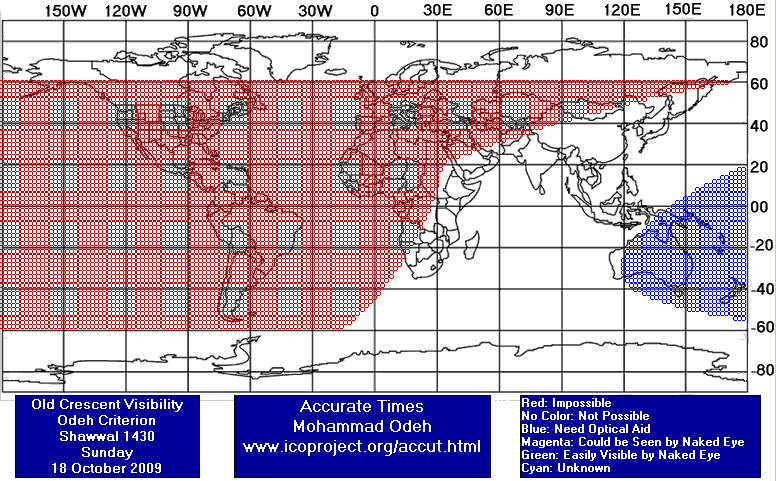
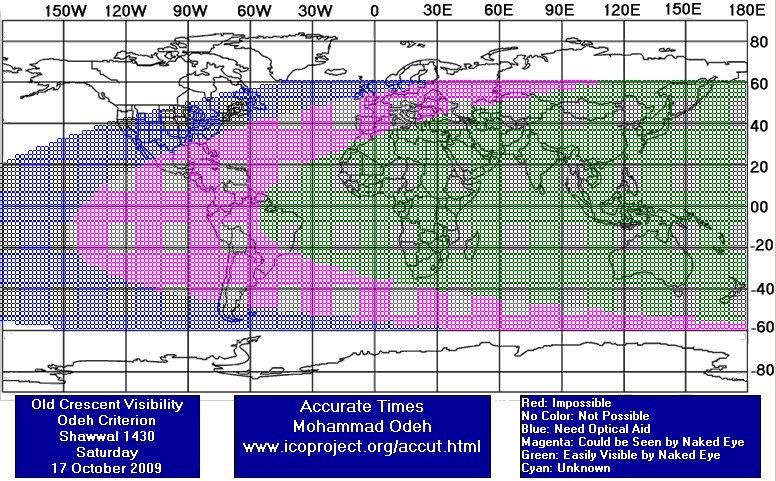
Shawwal Waning (OLD) Crescent Observation Results
Sat 17 October 2009
Nigeria
United Kingdom
Eng. Qamar Uddin said: "The eastern horizon was totally cloudy for last few days. There was no waning (old) crescent see this months. However, as this the first report on the new ICOP website, I am including last months (16 September 2009) photo for test purposes!"

